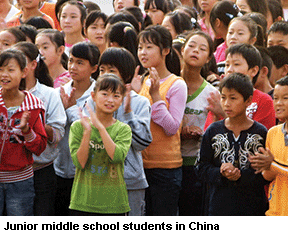LIKE MANY RURAL TEENAGERS, Yan Jingtao, the son of a watermelon farmer, did not have quite the stuff for a standard upper-secondary school. Last September, encouraged by his teacher, he and three classmates enrolled instead at a vocational school on the edge of the central city of Kaifeng to study computer animation. By November, he had quit; one of 23 dropouts in less than two months from a class that had started with 57. The students had often got into brawls and skipped school to play games at an internet cafe.
 Now 18, Yan has landed a decent short-term job as a guard at a local military airport. “My job is better than what my friends have,” he says. But he yearns to learn a skill and pursue a proper career. He will have too much company in that pursuit, and not much help.
Now 18, Yan has landed a decent short-term job as a guard at a local military airport. “My job is better than what my friends have,” he says. But he yearns to learn a skill and pursue a proper career. He will have too much company in that pursuit, and not much help.
In the past three decades, China has made impressive gains in sending rural children to school. This has helped fuel its rise as a low-end manufacturing power. But the easy gains have been achieved. If the country is to create the ‘knowledge economy’ it says it wants, the government will have to change the way rural teenagers are educated and schools in the countryside are funded.
Completion of junior middle-school has been compulsory since 1986. (Middle-school in China refers to the six years of education before university.) In big cities it’s already the norm to finish the remaining three years, known as senior middle-school. In the countryside, growing numbers are entering senior middle-school too, but it’s far less common. In 1990, just 7 percent of rural students did so. Today the figure may be just over one-third. Even at the junior level (despite government figures suggesting full attendance), dropout rates are high: a study of rural students in four provinces found they ranged between more than one-sixth to nearly a third.
In middle-school attendance, China lags behind the attainments of some newly developed economies when they were at similar levels of development. In South Korea, virtually everyone was getting a full secondary education by the late 1980s. By contrast, says Niny Khor, an economist in Beijing at the Asian Development Bank, China has an urban-rural gap of close to three years of education. Ms. Khor calls rural upper-secondary schools “the biggest bottleneck” of the education system.
The government encourages teachers to steer academic underachievers to vocational schools. It gives a subsidy of 1,500 yuan (Rs.15,000) each to many rural vocational school students to help cover tuition. Measures like these helped to boost enrolment in such schools by nearly 50 percent, to 6.9 million, in the decade to 2011. But vocational schools in rural areas, no less than their middle-school counterparts, are blighted by scant funding and poor-quality staff. Students still have to pay, hence richer ones enroll more than poorer ones. And their value is questionable. One study found students scored worse in maths after completing a year of vocational secondary school. Many experts argue that providing more opportunity for students to stay in standard secondary schools would prepare them better for the workplace. But that would land the government with a huge new bill.
(Excerpted and adapted from The Economist)